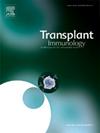使用机器学习检查影响肾移植后新生hla特异性抗体发展的移植前因素。
IF 1.4
4区 医学
Q4 IMMUNOLOGY
引用次数: 0
摘要
导言:在肾移植中,针对HLA的供体特异性抗体(dsa)的发展与移植物过早衰竭有关。然而,报告的发病率和影响因素差异很大。我们的目的是利用机器学习(ML)确定影响新生hla特异性抗体发展的移植前因素。方法:对单个中心460例肾移植受者(2009-2014年)的数据进行分析。收集移植前临床和免疫学指标,并对移植后血清进行HLA抗体筛选。阳性样品进行单抗原珠(SAB)检测。ML模型(CART, RF, XGBoost, CatBoost)在一组移植前数据上进行训练,以预测有无SMOTE过采样的dnDSA形成。使用F1分数评估模型性能,使用SHAP评估特征重要性。结果:在整个队列中,115名患者(25 %)产生了dnhla特异性抗体,其中36名患者(31 %)患有dndsa。XGBoost在没有SMOTE的情况下获得了最佳性能(F1为0.54-0.59);SMOTE为0.72-0.79)。单因素分析发现了重要的预测因素:移植前hla特异性抗体(p )结论:ML模型可用于识别移植前hla特异性抗体发展的危险因素。基于这些因素的监测和风险分层可以为免疫策略和受体选择提供信息,以改善长期的同种异体移植结果。翻译说明:本研究确定了肾移植中发生新生DSA的移植前危险因素。基于这些因素对患者进行监测和风险分层可能有助于指导预防性免疫策略和受体选择,以改善长期的同种异体移植结果。本文章由计算机程序翻译,如有差异,请以英文原文为准。
Using machine learning to examine pre-transplant factors influencing De novo HLA-specific antibody development post-kidney transplant
Introduction
The development of de novo donor-specific antibodies (DSAs) against HLA is associated with premature graft failure in kidney transplantation. However, reported rates and contributing factors vary widely. We aimed to identify pre-transplant factors influencing de novo HLA-specific antibody development using machine learning (ML).
Methods
Data from 460 kidney transplant recipients at a single centre (2009–2014) was analysed. Pre-transplant clinical and immunological variables were collected, and post-transplant sera were screened for HLA antibodies. Positive samples underwent Single Antigen Bead (SAB) testing. ML models (CART, RF, XGBoost, CatBoost) were trained on a set of pre-transplant data to predict dnDSA formation, with and without SMOTE oversampling. Model performance was evaluated using F1 scores, and feature importance was assessed using SHAP.
Results
In the full cohort, 115 patients (25 %) developed dnHLA-specific antibodies, including 36 (31 %) with dnDSAs. XGBoost achieved the best performance (F1 0.54–0.59 without SMOTE; 0.72–0.79 with SMOTE). Univariate analysis identified significant predictors: pre-transplant HLA-specific antibodies (p < 0.001), prior transplantation (p < 0.001), cold ischaemia time (CIT) (p = 0.02), female gender (p = 0.01), younger age (p = 0.03), HLA mismatch (p = 0.01), aminoacid mismatch (p = 0.01), and depleting induction (p = 0.01). SHAP plots confirmed the importance of pre-existing antibodies and re-transplantation. Extremes of CIT and age ≥ 65 was associated were associated with reduced predicted risk. Model performance in the unsensitised subgroup was limited (F1 < 0.2).
Conclusion
ML models can be used to identify pre-transplant risk factors for de novo HLA-specific antibody development. Monitoring and risk-stratification based on these factors may inform immunological strategies and recipient selection to improve long-term allograft outcomes.
Translational statement
This study identified pre-transplant risk factors for the development of de novo DSA in kidney transplantation. Monitoring and risk-stratifying patients based on these factors may help guide preventive immunological strategies and recipient selection to improve long-term allograft outcomes.
求助全文
通过发布文献求助,成功后即可免费获取论文全文。
去求助
来源期刊

Transplant immunology
医学-免疫学
CiteScore
2.10
自引率
13.30%
发文量
198
审稿时长
48 days
期刊介绍:
Transplant Immunology will publish up-to-date information on all aspects of the broad field it encompasses. The journal will be directed at (basic) scientists, tissue typers, transplant physicians and surgeons, and research and data on all immunological aspects of organ-, tissue- and (haematopoietic) stem cell transplantation are of potential interest to the readers of Transplant Immunology. Original papers, Review articles and Hypotheses will be considered for publication and submitted manuscripts will be rapidly peer-reviewed and published. They will be judged on the basis of scientific merit, originality, timeliness and quality.
 求助内容:
求助内容: 应助结果提醒方式:
应助结果提醒方式:


